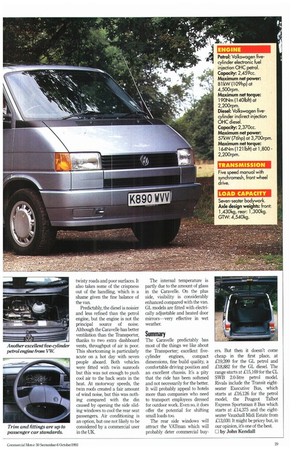Volkswagen Caravelle GL
Page 30

Page 31

If you've noticed an error in this article please click here to report it so we can fix it.
The VW Transporter has passed through our hands in practically every loadcarrying guise; 800kg van, LWB high-roof, chassis cab and 4x4 synchro. The notable omission was the Caravelle human cargo carrier, available with a variety of engines and seating arrangements. We've driven the petrol and diesel seven-seater GL models, in both five-cylinder petrol and diesel form, to see how the Caravelle stacks up as a minibus,
The Caravelle broadly mirrors the Transporter van range as far as body styles and engines are concerned. There's a choice of short or long wheelbase with seven or eight seats. Under the bonnet, buyers can choose between two petrol and two diesel engines. Spark ignition offers either a 62kW (83hp) 1,968cc four-pot or 81kW (109hp) 2,459cc five-pot, both with exhaust catalysts. Diesel buyers can choose between the familiar 57kW (76hp) 2,370cc five-pot diesel or the new-for-'94 turbocharged and catalysed "Umwele 1.9litre diesel. We've driven the the five-pot models; the 2.5-litre petrol and 2.4-litre diesel.
Productivity
Both vehicles are equipped with seven seats in three rows. The lower-spec CLs are offered with eight seats, but the GL sevenseaters offer more flexibility.
Single front seats with folding armrests replace the Transporter's driver and double passenger seat. As an option, the front seats can swivel and our diesel test vehicle was so equipped. The second row seats two in one removable seat. The offside of the two has the advantage of a lap and diago nal seatbelt while the nearside, sited next to the side sliding door is only fitted with a lap belt.
Both are fitted with a fold-down armrest and the backrest will fold flat to provide a table top. All 1994 models will be offered with two single seats with lap and diagonal seat belts. They will still be removable and should be easier to shift than the heavy double seat of our test vehicles.
In the back row, seating for three runs the full width of the vehicle. There are seat belts for all three, with a lap belt for the middle seat. This row of seats can be tilted forward but not removed. Behind it, there is adequate room for luggage or small pieces of equipment, while side compartments provide stowage for tools and a jack.
Our experience with a longterm test Transporter van, powered by the five-cylinder diesel, shows how fuel efficient this engine can be. In our hands it returned 8.81it/100Iun (32.1mpg) over a year and this ties in with the best/worse German DIN figures for the Caravelle.
However, the five-pot petrol could see unleaded off at an alarming rate. Around 131it/ 1001cm—low 20s mpg—was the norm in our hands.
This was the price of performance. As the relative power and torque figures suggest, the petrol engine packs a far bigger punch. The petrol model can certainly cover the ground faster than the diesel, but both will cruise happily at motorway speeds.
The Caravelle is not best suited to dual-purpose load/people carrying, despite the removable seats. The cloth trim and wall-to-wall carpet definitely err on the side of moving humans in relative comfort. So does the ride.
Gone is the taut damping of the van. The Caravelle has a much more pronounced tendency to roll and wallow than its loadcarrying stablemate, thanks to softer damping rates. This is fine on a motorway with consistent road surfaces and long gentle bends but is uncomfortable on twisty roads and poor surfaces. It also takes some of the crispness out of the handling, which is a shame given the fine balance of the van.
Predictably, the diesel is noisier and less refined than the petrol engine, but the engine is not the principal source of noise. Although the Caravelle has better ventilation than the Transporter, thanks to two extra dashboard vents, throughput of air is poor. This shortcoming is particularly acute on a hot day with seven people aboard. Both vehicles were fitted with twin sunroofs but this was not enough to push cool air to the back seats in the heat. At motorway speeds, the twin roofs created a fair amount of wind noise, but this was nothing compared with the din caused by opening the side sliding windows to cool the rear seat passengers. Air conditioning is an option, but one not likely to be considered by a commercial user in the UK. The internal temperature is partly due to the amount of glass in the Caravelle. On the plus side, visibility is considerably enhanced compared with the van. GL models are fitted with electrically adjustable and heated door mirrors—very effective in wet weather.
The Caravelle predictably has most of the things we like about the Transporter; excellent fivecylinder engines, compact dimensions, fine build quality, a comfortable driving position and an excellent chassis. It's a pity that the ride has been softened and not necessarily for the better. It will probably appeal to hotels more than companies who need to transport employees dressed for outdoor work. Even so, it does offer the potential for shifting small loads to
The rear side windows will attract the VATrnan which will probably deter commercial buy
em. But then it doesn't come cheap in the first place, at £19,399 for the GL petrol and £18,882 for the GL diesel. The range starts at £15,169 for the CL SWB 2.0-litre petrol model. Rivals include the Transit eightseater Executive Bus, which starts at £16,126 for the petrol model, the Peugeot Talbot Express Sportsman 8 Bus which starts at £14,375 and the eightseater Vauxhall Midi Estate from £13,030. It might be pricey but, in our opinion, it's one of the hest.
0 by John Kendall
























































































